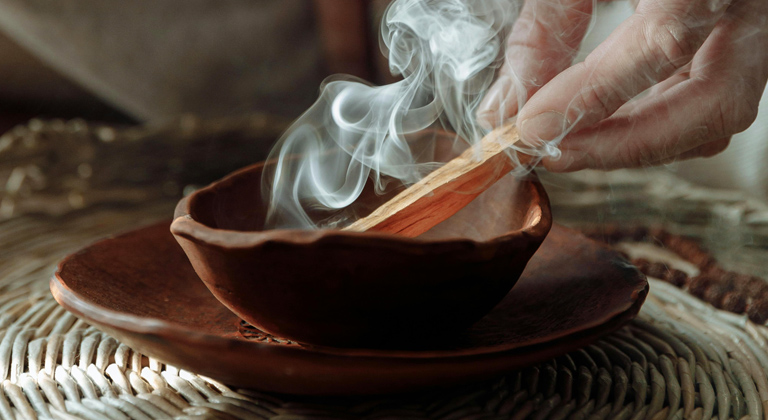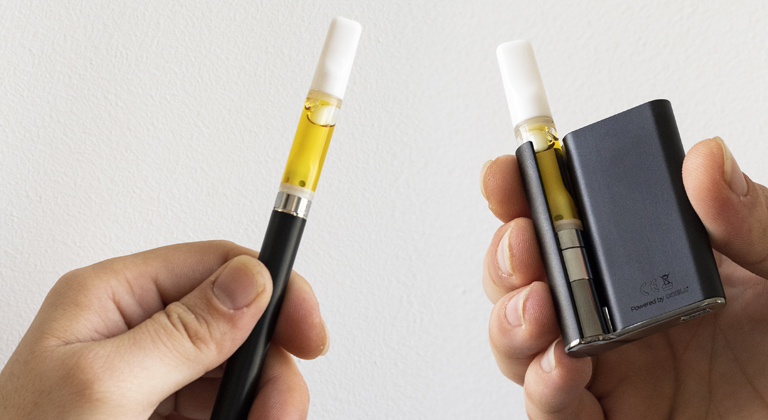What is Palo Santo?
Palo Santo, commonly referred to as “sacred wood”, is a tree species (Bursera graveolens), native to the Americas, which thrives in Peru, Guatemala, Honduras and Ecuador, among other countries.
This aromatic wood has been used for centuries in Indigenous spiritual ceremonies throughout Latin America and has now gained popularity in the wellness and personal care industry.
Properties and Uses of Palo Santo
Traditionally, Palo Santo is used by burning small chips or pieces of its wood, which when combusted, creates an aromatic smoke believed to purify the air, ward off negative energies, attract good luck and enhance mood.
Research has shown that Palo Santo’s essential oil contains antibacterial, antifungal and anti-inflammatory properties, making it a valuable remedy in traditional medicine for centuries.
In addition, this oil is utilized for its abilities to:
- Reduce stress and enhance mental clarity in aromatherapy.
- Alleviate pain: Traditionally, Palo Santo has been used to relieve pain related to arthritis, as well as soothe sore throats and headaches.
- Repel mosquitoes and other insects.
- Promote relaxation: Burning Palo Santo has become a convention in religious ceremonies and is commonly done during meditation sessions. This is because its aroma stimulates the brain’s olfactory system in a way that induces a physical relaxation response.
Surprisingly, these benefits are only found when a Palo Santo tree dies naturally and is allowed to decompose for five to eight years. This timeframe allows the oils in the wood to fully mature before being harvested and processed into sticks or essential oils.
But, what makes this sacred wood generate all these beneficial effects?

Terpenes: The Secret Ingredients of Palo Santo
Thanks to science, we’re now able to partly unravel the health benefits of this so-called sacred wood. Certain studies (2), have analyzed Palo Santo’s essential oil composition, finding that this species produces terpenoid resins from monoterpenes to triterpenes, and rarely diterpenes (Steyermark, 1987). The percentage composition of monoterpenes varies geographically due to climatic factors.
In other words, just like cannabis, Palo Santo produces a good amount of terpenes, which is why it has the benefits and properties mentioned in the previous section.
A study focused on the aromatic composition of Palo Santo resin revealed that the amounts of terpenes vary depending on the geographical area where it grew and the part of the plant used for analysis.
This implies that the climate, cultivation conditions, and regional location influence the concentration and presence of the terpenes. This is also true with cannabis, as its terpene composition varies mainly based on genetics (though cultivation conditions also play a part), and at the heart of the matter, it’s an adaptive factor; as the different cannabis strains (formerly commonly classified as indica and sativa) are a result of the plant’s adaptation to the environment.
Let’s not forget that terpenes are a plant’s defense system against predators and environmental factors, hence, it makes sense to think that the terpene composition also “adapts” to the plant’s needs or “dangers” of each region.
According to several studies conducted on the aromatic composition of Palo Santo (3), (4), the terpenes found in the greatest quantities in the plant are:
Terpinene: An Ally Against Pain and Bacteria
This terpene found in significant quantities in Palo Santo’s composition has shown to have the following properties:
- Antioxidant and Anti-inflammatory: helping to reduce cellular damage and body inflammation (5).
- Antimicrobial: Terpinene has shown antimicrobial activity, making it effective at combating certain bacteria and fungi.
- Muscle Relaxant and Analgesic: This terpene can promote muscle relaxation and alleviate pain due to its effects on the central nervous system.

P-Cymene: The Antioxidant Power
P-Cymene is another main terpene found in Palo Santo’s essential oil. Its multiple properties include:
- Antioxidant and Anti-inflammatory: This terpene is a powerful antioxidant that also helps to reduce cell inflammation and protect them from oxidative processes. (10)
- Antimicrobial: Scientific studies have shown that P-Cymene has antimicrobial properties, therefore helping to fight against a variety of bacterial and fungal pathogens.
An analgesic and anti-nociceptive: This terpene can act as an analgesic and anti-nociceptive agent, relieving pain and reducing pain sensitivity.
Limonene: The Secret Ingredient that Connects Palo Santo and Cannabis
As you may have guessed, what Palo Santo and the cannabis plant have in common, apart from both having beneficial health properties, are the terpenes. Specifically, Limonene, as this terpene is found in large amounts in both species and, although they share other terpenes like Pinene or Myrcene, these are present in very small amounts in Palo Santo’s composition, hence not considered a significant similarity.
However, it’s interesting that Limonene is found in high amounts in two of the plants considered sacred by ancestral cultures for centuries, or is it?
Indeed, this terpene produces powerful effects that make us feel better, thus it’s one of the reasons both plants have been used to improve certain ailments. Let’s look at what properties Limonene has:
- Neuroprotective: Scientific studies (7), have shown that Limonene shows neuroprotective potential, helping in reducing oxidative stress, inflammation and regulating cellular apoptosis (cell death). Therefore, this compound could be useful in treating or preventing neurodegenerative diseases.
- Anti-inflammatory and Antioxidant: Scientific studies (8), indicate that Limonene helps protect against cellular damage and reduce inflammation.
- Anticancer: Some studies (9), suggest that Limonene is an active compound that may contribute to both the therapy and prevention of cancer, seeming to inhibit tumor growth and promote apoptosis in cancer cells. However, further research is needed on its possible applications in such treatments.
- Mood Elevator: It’s a natural stimulant that can improve mood, with clinical trials showing improvements in individuals with low levels of endocrine hormones.
- Promotes Focus: Limonene helps promote mental clarity and focus.
- Antianxiety: Many people mistake Limonene’s stimulating properties for exciting effects, far from it, as this terpene has demonstrated antianxiety properties that help to reduce anxiety and nervous stress.
- Antifungal Properties: This aromatic compound inhibits the proliferation of certain fungi, especially those that affect food products.
Similarities Between Palo Santo and Cannabis
As we’ve just explained, both cannabis and Palo Santo are plants that have been considered sacred in ancestral cultures. The explanation for this reverence towards these plants rather than others probably lies in their therapeutic properties.
Nowadays, thanks to science, we can decipher why these plants have beneficial effects on health, and not only that but also the compounds responsible for these wellness effects!
Limonene is undoubtedly a principal component in both species and partly responsible for their functional effects.
Many cannabis strains also contain a high Limonene content, and curiously, they also produce similar effects: focus, mood elevation, antianxiety effects and more.
Strains like Chocolate Mint OG, 3 Kings, Sour Diesel, and Orange Turbo, have achieved worldwide fame not just for their exquisite taste but also their effects.
Seemingly, nature gifts us once again with tools that, when properly utilized, can contribute to our wellbeing. As we’ve just confirmed, both Palo Santo and cannabis share terpenes that contribute to their calming effects, stress reduction and may promote a state of balance and mental peace.

How to Integrate Palo Santo and Cannabis into Your Wellness Routine
There are many ways to benefit from the properties of both plants, and although cannabis is most commonly used through combustion, nowadays there’s a wide range of usage methods that don’t necessarily involve smoking or even experiencing the psychoactive effects of cannabinoids.
You can reap the functional properties of terpenes without needing to experience the intoxication often associated with cannabis:
- Vaporization and Aromatherapy: Use Palo Santo essential oils and cannabis terpene profiles in a diffuser to enjoy their combined benefits. However, remember that Cali Terpenes’ cannabis terpene profiles are a highly concentrated product, so consult us for the appropriate doses in each case to achieve a positive result. In this instance, less is definitely more!
- Oils and balms: Apply oils or balms containing extracts with terpene profiles of both plants to painful areas to utilize their anti-inflammatory and analgesic properties.
- Meditation rituals: Incorporating Palo Santo and Cannabis into your meditation practices to create a calm and relaxed atmosphere can be a way to foster a conducive environment for focusing your mind on your practice.
Precautions and Considerations
It’s important to bear in mind that, although both plants have many benefits, they can also have interactions and contraindications. It’s recommended to consult with a healthcare professional before incorporating new products into your routine. Moreover, ensure to obtain quality and certified origin products to avoid adverse effects.
Frequently Asked Questions (FAQ)
- Is it safe to use Palo Santo and Cannabis together?
Yes, but it’s recommended to start with low doses and to consult with a healthcare professional.
- Where can I get quality Palo Santo and Cannabis products?
Look for providers with certifications and good manufacturing practices.
- Are there scientific studies that back up the combined benefits?
Yes, studies exist that show the individual benefits of both plants and how their components can complement each other. Below, you’ll find a series of scientific studies that can help you obtain reliable information on this topic.

Conclusion
Palo Santo and Cannabis are two powerful plants with many beneficial properties in common. From their relaxing effects to their anti-inflammatory properties, both can be valuable allies in your wellness routine.
Have you ever used Palo Santo and Cannabis together? We encourage you to share your experience, help us build a more informed and conscious community!
- de Cássia da Silveira E Sá R, Lima TC, da Nóbrega FR, de Brito AEM, de Sousa DP. Analgesic-like activity of essential oil constituents: An update. Int J Mol Sci. 2017;18(12):2392. doi:10.3390/ijms18122392
- López-Cordova, C.M.,Capa-Camacho, V.L.,García-Berfon, L.V.,García-López, A.L.,(2020). Transformación catalítica del aceite esencial de Palo Santo sobre zeolita Faujasita HY. Ingeniería Investigación y Tecnología, 21 (02), 1-9. https://doi.org/10.22201/fi.25940732e.2020.21n2.013
- Sotelo Mendez, A. H., Figueroa Cornejo, C. G., Coral, M., & Arnedo, M. (2017). Chemical Composition, Antimicrobial and Antioxidant Activities of the Essential Oil of Bursera graveolens (Burseraceae) From Perú. Indian Journal of Pharmaceutical Education and Research, 51.
- Figueroa Cornejo, C. G., Coral, M., & Arnedo, M. (2017). Chemical Composition, Antimicrobial and Antioxidant Activities of the Essential Oil of Bursera graveolens (Burseraceae) From Perú. Indian Journal of Pharmaceutical Education and Research, 51.
- Mendez, A., Cornejo, C., Coral, M., & Arnedo, M. (2017). Chemical Composition, Antimicrobial and Antioxidant Activities of the Essential Oil of Bursera graveolens (Burseraceae) From Perú.. Indian Journal of Pharmaceutical Education and Research, 51. https://doi.org/10.5530/ijper.51.3s.62.
- Eddin, L., Jha, N., Meeran, M., Kesari, K., Beiram, R., & Ojha, S. (2021). Neuroprotective Potential of Limonene and Limonene Containing Natural Products. Molecules, 26. https://doi.org/10.3390/molecules26154535.
- Lujain Bader Eddin, N. Jha, M. Meeran, K. Kesari, R. Beiram and S. Ojha. “Neuroprotective Potential of Limonene and Limonene Containing Natural Products.” Molecules, 26 (2021). https://doi.org/10.3390/molecules26154535.
- Yu, L., Yan, J., & Sun, Z. (2017). D-limonene exhibits anti-inflammatory and antioxidant properties in an ulcerative colitis rat model via regulation of iNOS, COX-2, PGE2 and ERK signaling pathways.. Molecular medicine reports, 15 4, 2339-2346 . https://doi.org/10.3892/mmr.2017.6241.
- Retajczyk, M., & Wróblewska, A. (2018). Therapeutic applications of limonene. Pomeranian journal of life sciences, 64. https://doi.org/10.21164/POMJLIFESCI.404.
- Balahbib, A., Omari, N., Hachlafi, N., Lakhdar, F., Menyiy, N., Salhi, N., Mrabti, H., Bakrim, S., Zengin, G., & Bouyahya, A. (2021). Health beneficial and pharmacological properties of p-cymene.. Food and chemical toxicology : an international journal published for the British Industrial Biological Research Association, 112259 . https://doi.org/10.1016/j.fct.2021.112259.
- Marchese, A., Arciola, C., Barbieri, R., Silva, A., Nabavi, S., Sokeng, A., Izadi, M., Jafari, N., Suntar, I., Daglia, M., & Nabavi, S. (2017). Update on Monoterpenes as Antimicrobial Agents: A Particular Focus on p-Cymene. Materials, 10. https://doi.org/10.3390/ma10080947.









